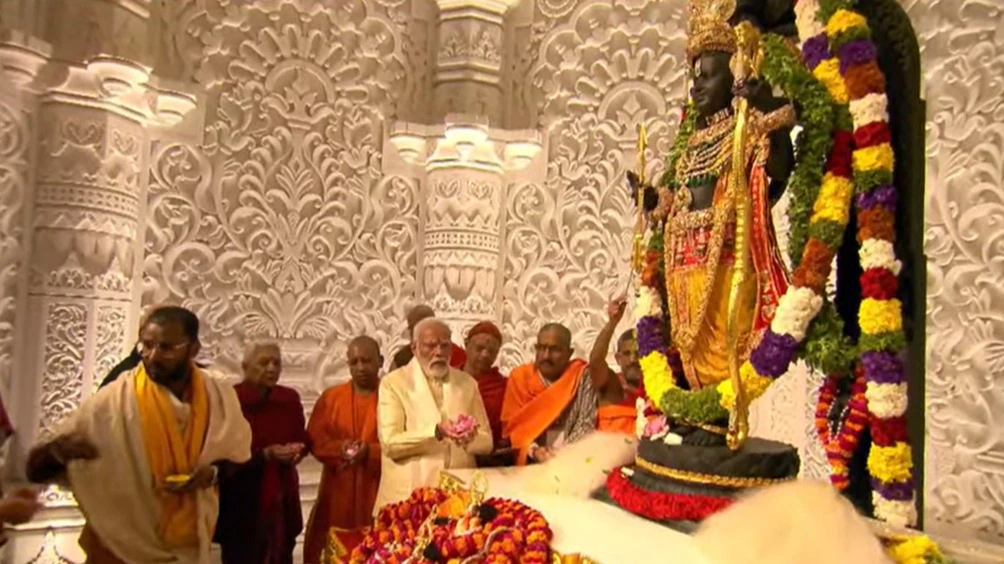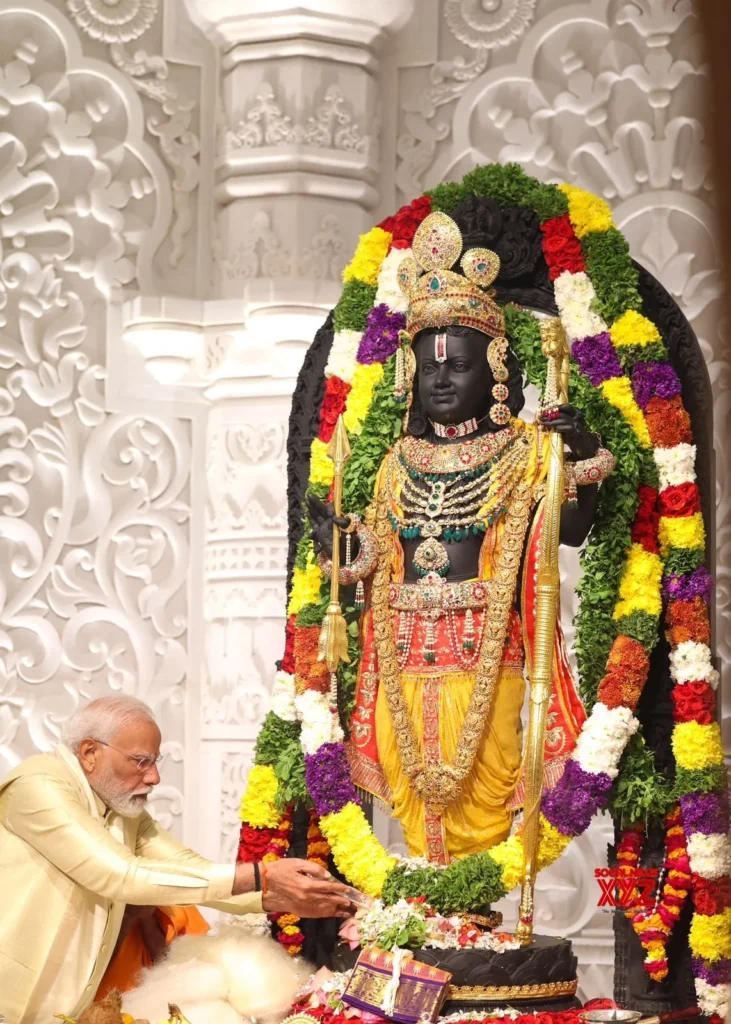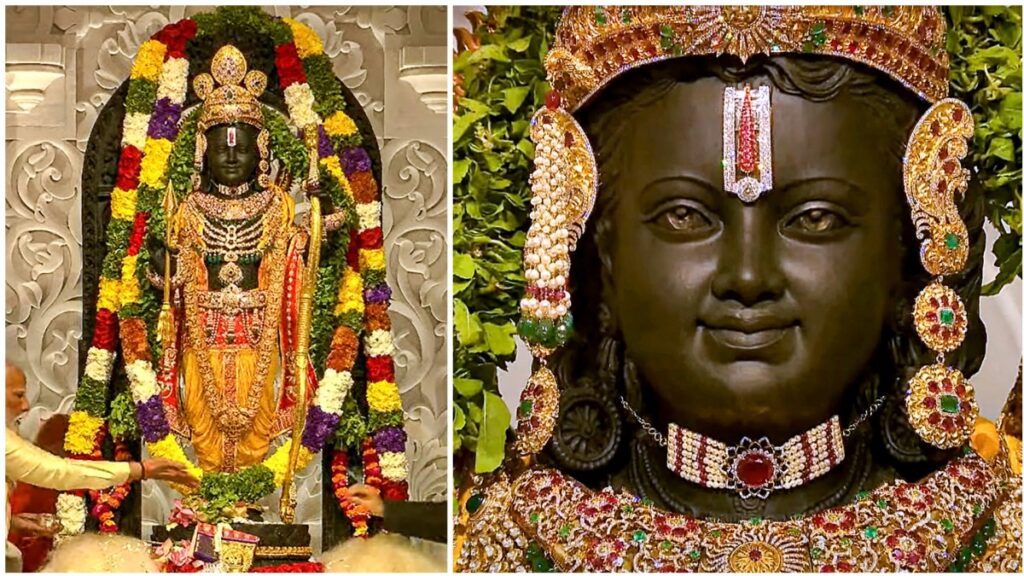PM Modi leads rituals in Ayodhya as Lord Ram’s homecoming is celebrated across India……


Prime Minister Narendra Modi, as the ‘yajman’, conducted the ‘Pran Pratishtha’ ceremony at the Ram Mandir in Ayodhya. Subsequently, the unveiling of the first image of Ram Lalla, the divine child form of Lord Ram, took place.
Prime Minister Narendra Modi presided over the ‘Pran Pratishtha’ rituals at the Ram Mandir in Ayodhya on Monday, signifying the long-awaited return of Lord Ram after five centuries. The initial glimpse of the idol of Ram Lalla, skillfully crafted by renowned sculptor Arun Yogiraj from Mysuru, was unveiled to the world as the veil covering its eyes was gently removed.
During the consecration ceremony, the exquisitely adorned Ram Lalla idol was adorned with opulent gold jewelry, as well as precious diamond, emerald, and ruby ornaments. The idol gracefully holds a bow and arrow, both crafted from pure gold.
Prior to the 84-second ‘muhurta’ of PM Modi’s ‘Pran Pratishtha’, he engaged in pre-Pran Pratishtha ceremonies alongside RSS chief Mohan Bhagwant seated beside him.
After the completion of the ‘Pran Pratishtha’ rituals in Ayodhya, the prime minister concluded his 11-day fast by consuming ‘Charanamrit’, a sweet milk-based drink used in religious ceremonies. The drink was offered to him by Govind Dev Giri Maharaj, the Treasurer of Shri Ram Janmabhoomi Tirtha Kshetra, which oversees the management of the temple. In addition, Prime Minister Narendra Modi showered flower petals on the workers involved in the construction of the magnificent Ram Temple. During his address to the large gathering, he emphasized that Ram is not a source of conflict but rather a solution. PM Modi stated, “Ram symbolizes energy, not fire. Ram is not a dispute, but rather the answer. Ram does not belong to a select few, but to everyone. Ram is not confined to the present, but is eternal.” He also expressed his gratitude to the Supreme Court for ensuring justice and enabling the construction of the temple.
Today, several states and Union territories, such as Uttar Pradesh, Gujarat, Chhattisgarh, Himachal Pradesh, Assam, Haryana, and Jammu and Kashmir, among others, have declared either a holiday or a half day. This decision was made by the central government to allow employees at various institutions to participate in the celebration.
However, the Opposition bloc INDIA has chosen to boycott the event. They have accused the ruling BJP and PM Modi of “politicising” the event, especially in light of the upcoming Lok Sabha elections.
The Ram Mandir was filled with thousands of guests, including renowned celebrities who arrived at the temple before the consecration ceremony. These notable figures include Bollywood icon Amitabh Bachchan, cricket legend Sachin Tendulkar and Anil Kumble, Bollywood superstars Katrina Kaif, Vicky Kaushal, Ranbir Kapoor, Alia Bhatt, and South actors Rajinikanth, Ram Charan, and Chiranjeevi, among others.
The temple’s design follows the traditional Nagara style and boasts impressive dimensions. It stretches 380 feet in length, 250 feet in width, and stands at a height of 161 feet. The temple complex, designed by Chandrakant Sompura and his son Ashish, covers an area of 70 acres, with the main temple occupying 2.7 acres and a total built-up area of approximately 57,000 square feet. The entire structure, valued at Rs 1,800 crore, has been funded by the Shri Ram Janmabhoomi Teerth Kshetra Trust. This trust has received donations totaling over Rs 3,500 crore from individuals across India and abroad.
The Ram Lalla idol, crafted by the renowned sculptor Arun Yogiraj from Karnataka, will be officially consecrated in the temple today. This idol, depicting Lord Ram as a five-year-old child, was placed inside the sanctum sanctorum on January 18 as part of the sacred rituals. The black-colored idol, measuring 51 inches, will now be worshipped alongside the current idol of Ram Lalla, which has been revered for the past 70 years. The consecration ceremony involved pre-Pran Pratishtha rituals that took place from January 16 to January 21. Prime Minister Modi, serving as the chief patron, performed the Pran Pratishtha rituals to infuse life into the idol of Ram Lalla. Under the guidance of Lakshmikant Dixit, a team of priests oversaw the main rituals. Prior to the ceremony, PM Modi had announced his participation in a special 11-day anushthaan (rituals) from January 12 to January 22. It is reported that PM Modi followed the practices prescribed by sacred texts, which included sleeping on the floor, consuming only coconut water, performing Gau-pooja (cow worship), and engaging in various forms of daan (charitable acts) such as annadaan (donating food) and donating clothes.
Ayodhya, the temple town, has implemented stringent security measures for the participation of VIPs and VVIPs in the consecration ceremony of Ram Lalla. The city’s hotels are fully booked at higher prices than usual due to the event. Uttar Pradesh DG (Law and Order), Prashant Kumar, stated that 13,000 forces have been deployed, and AI-powered CCTV cameras are being used to enhance the security system. Additionally, 10,000 CCTV cameras have been installed across the city for continuous monitoring. Anti-drone technology is also in place to ensure safety.
To ensure the safety of devotees and dignitaries arriving in Ayodhya for the ‘Pran Pratishtha’, anti-bomb and dog squads have been deployed at the newly inaugurated Maharishi Valmiki International Airport.
The dispute over the land in Ayodhya, believed to be the birthplace of Lord Ram, has been ongoing for centuries. Hindus claim that Babur, the Mughal emperor in the 16th century, constructed Babri Masjid on the site where an ancient temple dedicated to Lord Ram once stood.
The initial instance of violence at the site occurred in 1853, prompting the British colonial administration to construct a fence in 1859, which separated the worship areas for Muslims and Hindus.
In 1949, idols of Lord Ram and Sita were placed inside the mosque, causing further tensions and resulting in the government locking the gates. This action sparked a series of lawsuits from Hindu and Muslim organizations, each claiming rights to the site.
The legal battle escalated in the 1980s when the Babri Masjid gates were opened for Hindu worshippers in 1986, following a court order. On December 6, 1992, a mob of Hindu activists demolished the Babri Masjid, triggering widespread communal violence and further complicating the legal proceedings.
In 2010, the Allahabad High Court delivered a verdict that divided the disputed land into three parts: one-third for the Sunni Waqf Board, one-third for the Nirmohi Akhara, and one-third for the deity Ram Lalla Virajman.
This ruling was contested, and on November 9, 2019, the Supreme Court of India issued a landmark judgment. The court ordered the transfer of the disputed 2.77 acres of land to a trust established by the Indian government for the construction of the Ram Mandir. Additionally, the court directed the provision of an alternate plot of five acres to the Sunni Waqf Board for the construction of a mosque.
